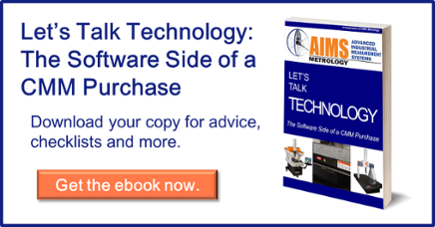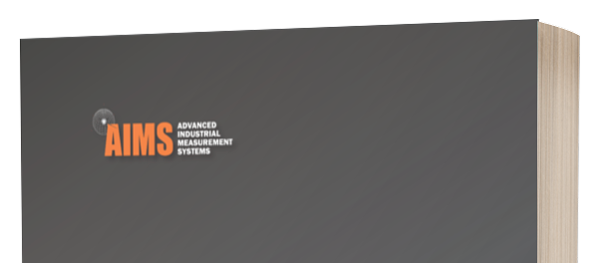
These days, when it comes to measuring parts, manufacturers have their choice of coordinate measuring machines (CMMs), many of which can perform touch, non-contact, and mobile inspection. Take, for example, the lab-grade Revolution Linear Motor (LM) CMM. Advanced CMM technology like Renishaw’s REVO 2 allows it to perform non-contact inspection, while its precision measuring head and probe system collects data at a rate of 4,000 points per second. Additionally, infinite positioning and 5-axis motion offers access to complex features. Add Renishaw's PH20 and use the LM for 5-axis touch trigger work. Need mobility? Consider the Revolution Series HB. It uses PH20 technology, making it the only mobile 5-axis CMM on the market. See? Lots of choices.
Given these options and more, you may wonder, "Is there ever a situation where a CMM isn’t the best option?" The answer is yes. What? As always, your application should guide your choice of inspection method and the right tool for the job. In addition to CMMs, gauges are another trusted metrology tool to consider.
It’s important to understand measuring and gauging are not the same thing. Measurement refers to directly taking a reading of a workpiece based on a scale (e.g. inches, millimeters, microns) to get an actual measurement. Gauging, on the other hand, is evaluating a workpiece against the specs or dimensions of a master part to determine how closely it matches. It all depends on the application.
In some cases, a CMM and a gauge can be complementary because they provide data about different aspects of the same part feature. As Hill Cox writes in Quality Magazine, “the CMM will take a number of measurements, usually pitch diameter established by two or more points of contact. Fixed limit gages inspect the thread through a functional check so if the thread is not round, they could reject it while the CMM may not even know this condition exists.”
Factors to Consider
So how do you know whether a CMM, gauge, or a combination is best? Consider these important points:
- What do you want to measure and how does that fit your application? Do you need actual dimensions of the specific part or an assurance that the part is within allowable tolerance of a master? Do you need to evaluate characteristics such as diameter, length, straightness, squareness, taper, roundness, concentricity, parallelism, or others? For example, “with a taper application, is it important to know just the angle or is important to also know the angle and the size of the diameters at locations along the taper?” this article in Quality Magazine
- What is the range of dimensions you’re dealing with? Air gauges often work best between 0.111” and 8” while CMM probe size can be a limiting factor for small or tight spaces. Tolerances are also a consideration. For example, fuel injector components are best suited to air or electronic gauging due to close tolerance requirements of 1/10 inch or less.
- Does part geometry affect measurability? There are several scenarios where CMMs may not be ideal, including tight tolerance bores with tight inner diameters, long, narrow reaches, or grooves and spirals (e.g., gun barrels).
- What is your desired cycle time, inspection location, and training capability? Measurement applications that require speed or ease-of-use may benefit from a gauge. They’re generally fast and require little extra skill to operate correctly, as opposed to a computer-based CMM. In addition, time and expertise needs change depending on if you’re inspecting in a lab, on the shop floor, or on the production line. For example, an automotive manufacturer uses a CMM to measure and inspect part features. However, when the job calls for an inspection of each part, the fabricator uses air and electronic gauging.
- Will surface finish have an impact? The relative smoothness or roughness of a workpiece can affect the accuracy of a CMM probe’s measurement, while a gauge may still be able to validate parts. “The measurement point of the [gauge’s] air jet is actually the average of the peaks and valleys the jet is exposed to. This is not the same measured point you would have if a contact type probe were used” according to the Quality Magazine article noted above.
The AIMS Metrology Difference
Going with an OEM that can provide both options means you have the solutions, service, and support for any part you must measure and inspect. AIMS Metrology is one of very few OEMs in the industry that can manufacture and support CMMs and gauges. The company builds custom gauges based on each customer’s requirements, resulting in zero size limitations. Gauges can be designed and built with the capability to check an automotive component every three seconds. Manual gauges that can check 20 to 30 features in 20 to 30 seconds are also available.
Are you a fabricator needing a vision system? AIMS has partnered with RAM Optical to provide a measurement solution for parts that can’t be subjected to contact, such as rubber gaskets. Air used as a back pressure system blowing through an air ring provides truly non-contact inspection and is especially useful for parts that can’t be scratched.
As you answer the questions posed above, be sure to look for an OEM that can match your needs to the best solutions. Each application is unique, so don’t take a one-size-fits-all approach. With AIMS Metrology, you won’t have to.
Editor’s note: This blog was originally published in 2017 and has been completely revised and updated.


